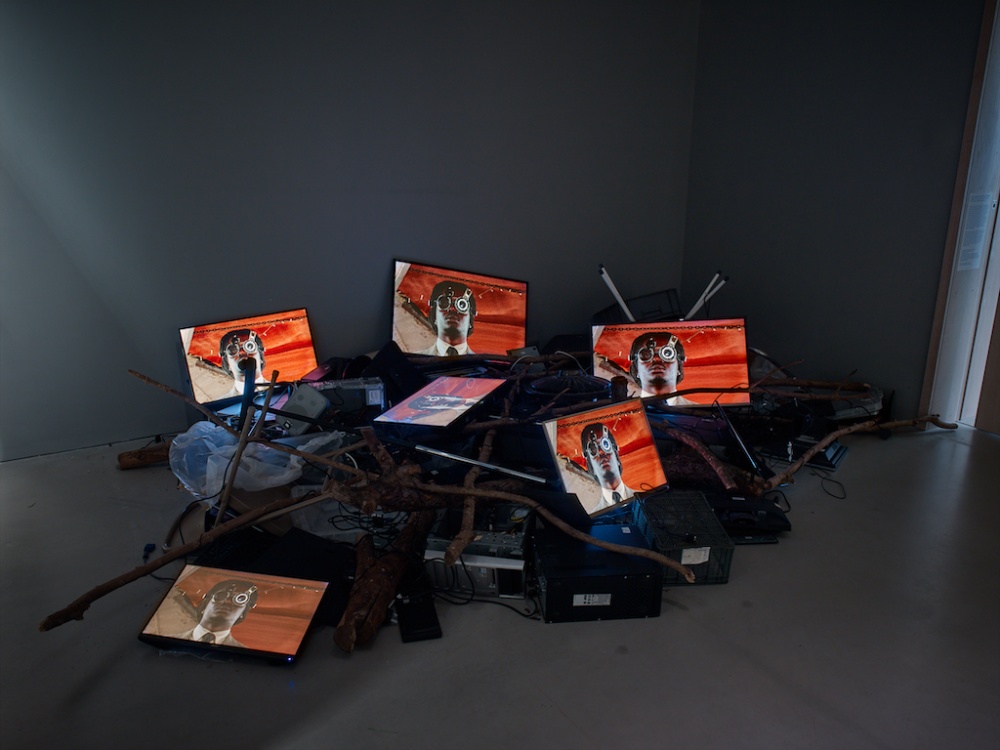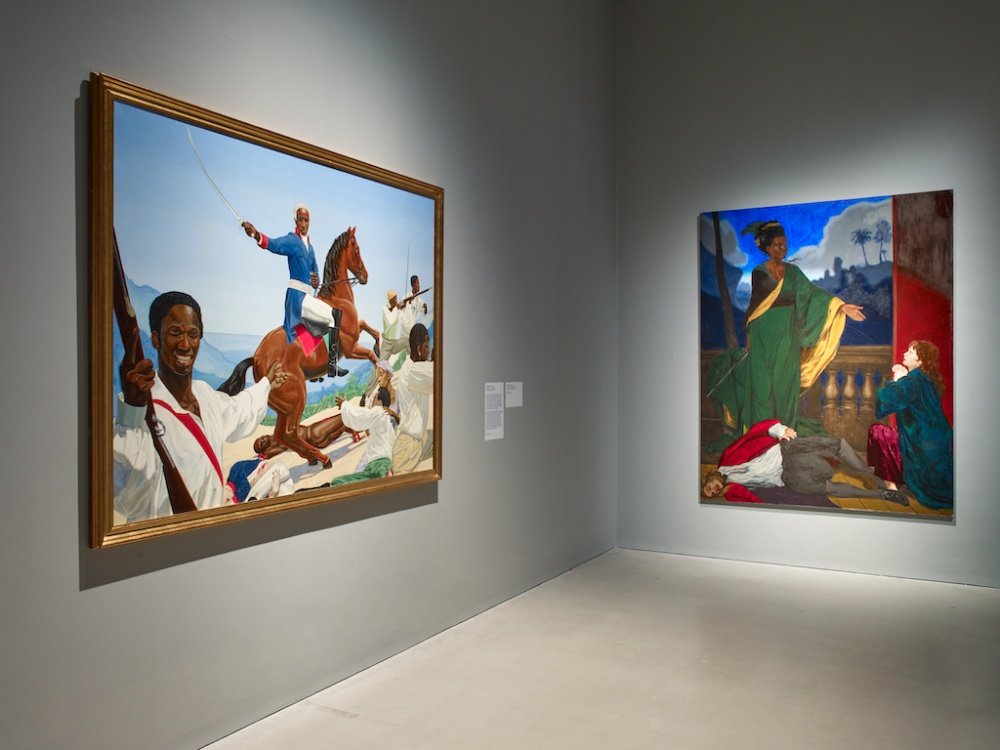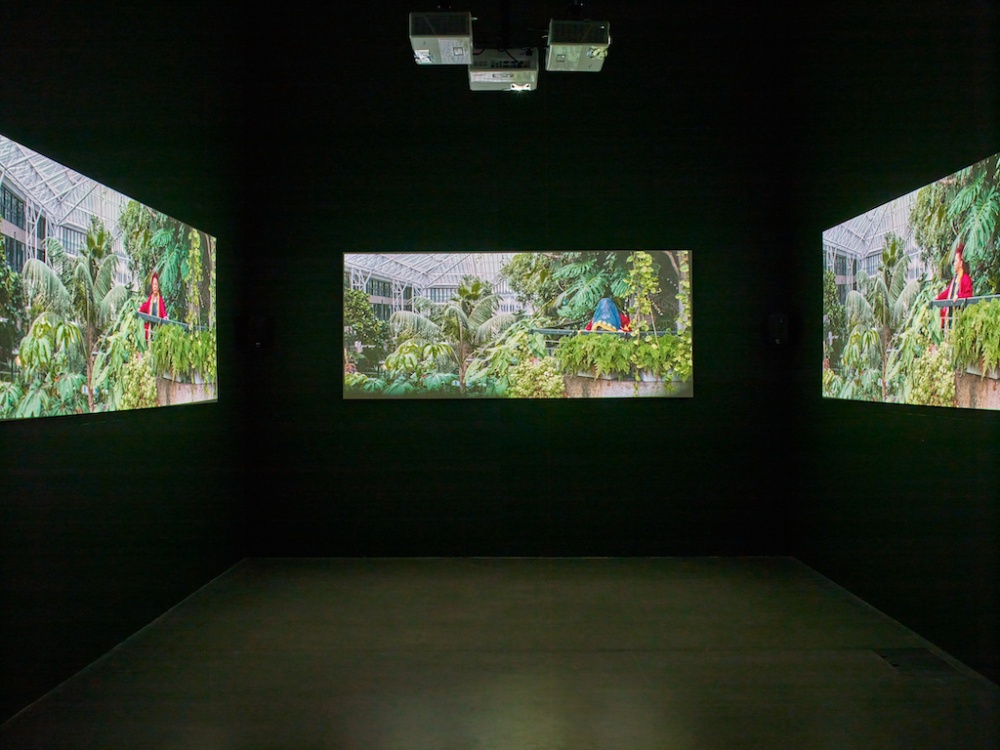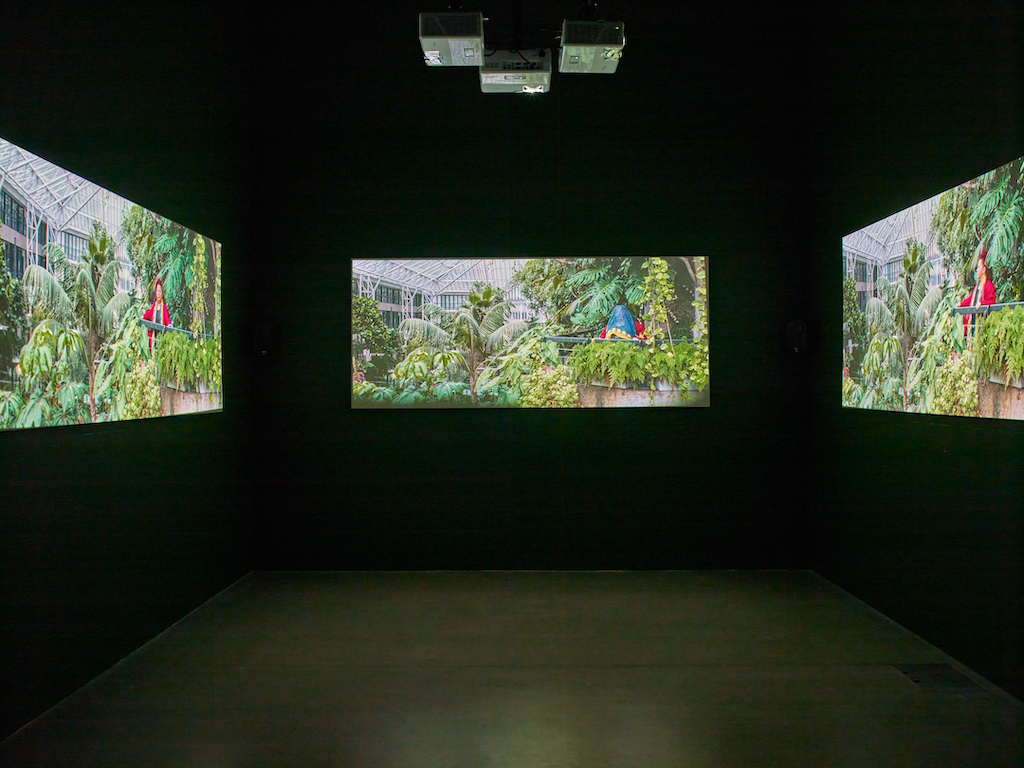From Art Journal 81, no. 2 (Summer 2022)
UNTITLED: Art on the Conditions of Our Time. Exhibition cocurated by Paul Goodwin and Guy Haywood. Kettle’s Yard, University of Cambridge, July 10–October 3, 2021.
When an artist purposefully leaves a work untitled (thereby titling it so), the insinuation is that a descriptive or connotative label would somehow upset the work’s efficacy by delimiting our experience of it. According to the press release, the leading principle behind UNTITLED: Art on the Conditions of Our Time, recently held at Kettle’s Yard, University of Cambridge, was “to encourage attention onto the works themselves, and eliminate reliance upon contextual information.” As such, curators Paul Goodwin and Guy Haywood asked “viewers to examine the conditions of our time through the prism of Black British artists working today, without reducing the encounter solely to an exploration of Black British identity.”1 At first, I was skeptical. How can Blackness as a signifier—relating to both histories of African diaspora and institutional goals of racial diversity—not be foregrounded in an all-Black show? Yet the exhibition followed through, proving my skepticism to be a reflection of its curatorial boldness. It achieved what it promised by divesting the viewer of a vantage point—the works in UNTITLED were seen from within rather than without; we could only effectively contextualize them by stepping outside them, which meant stepping outside the exhibition. Thus, while the show was concerned with many nameable “conditions,” its strength was grounded in its way of exhibiting condition as a phenomenological and ecological category in and of itself.
The condition of being locked within, as well as defined, scrutinized, and judged from without—from the vantage point of the oppressor—is a paradigm of Blackness most influentially explored by Frantz Fanon, the titular inspiration behind the first work I encountered: Larry Achiampong and David Blandy’s Finding Fanon: Part One, Part Two, Part Three (2015 and 2016–17). Epistemic imprisonment is the overriding theme of the sequence’s second video, in which the artists, having hacked into the video game Grand Theft Auto 5 (2013), have rendered themselves as avatars trapped inside a “virtual edifice.” The work was presented as a pile of discarded office equipment: hard drives, wires, desktop monitors, speakers, a bin lid, and so on. Among these were also tree branches, as if to remind us of the environmental impact of our neoliberal addiction to rendering things obsolete. The video sequence comprising the work’s main component was played on the monitors, with the accompanying voice-over emitted through the speakers. In previous installations of Finding Fanon (at Plymouth Arts Centre in 2017, for example), the video component has had more prominence, with the detritus often acting as an attendant prop. Here, engulfed by the mess, the films had a more sculptural presence, enhancing the installation’s unresolved, ambient tonality. Although, as a result, the formal complexity of the films may have been difficult to grasp, to give them more primacy might have weakened what I felt was the installation’s important contextual purpose: to tune our attention to the exhibition’s rich, Venn-diagrammatic network of imbrications and interrelations.
For example, Finding Fanon provided a thought-provoking counterpoint to Cedar Lewisohn’s eight prints, comic book, and large, hand-bound volume installed in the adjacent corner. The juxtaposition drew attention to the critical pertinence of Lewisohn’s use of the woodblock: information technology that was once revolutionary, ubiquitous, and necessary to the same extent that digital programming is today but has since lost its “public use.” Lewisohn’s prints evoke satirical cartoons, comic book illustrations, graffiti, and African sculpture—by way of critiquing its problematic presence in Western museums and modernism’s appropriation of it. In one of Lewisohn’s red-on-white prints forming part of his wordless comic book, The Marduk Prophecy (2020), a man waves his hands at a woman holding out a microphone. Rendered with ineffable economy, his fingers, disproportionately large, jagged, lizard-like, as if carved from wood, express protest. Another print depicts a man in what could be servant’s livery holding a tray of drinks, while in another appears a giant bird—maybe a person in carnivalesque costume—squawking or singing alongside another semihuman figure. Beside Achiampong and Blandy’s digital apocalypse, Lewisohn’s use of woodblock had the effect of slowing down time, engaging us to feel through the symbolic references, which are so entangled and interbred that, as with any clear sense of narrative, they resist easy parsing.


Kimathi Donkor’s paintings, Toussaint L’Ouverture at Bedourete (2004) and Queen Nanny of the Maroons’ Fifth Act of Mercy (2012), staged an alternate and imagined context of viewing evocative of the Western “heritage” art museum or stately home, critically alluding to the behavioral and phenomenological internalization of fixed versions of art history that such institutions tend to encourage. Fundamental to Donkor’s critique is his reappropriation—and destabilization—of the Grand Manner, a stylistic standard formulated in eighteenth-century Europe that provided an aesthetic foundation for white supremacy. In his depiction of Toussaint, a figure in the foreground smiles at the viewer, brandishing a gun in one hand, pointing at the Haitian rebel leader with the other. The painting has the sense of a snapshot, the figures caught in the exhilarating, confusing, and calamitous throes of revolution, quickly pulling a pose for a photographer. Such hurriedness and chaos—and perhaps also bathos—annihilate any trace of the earnest grandeur of Jacques-Louis David’s Napoleon Crossing the Alps (1801), for instance, which the work might otherwise recall (it therefore differs from Kehinde Wiley’s 2005 take on David’s painting, which seems to alter only its iconography). So does the naked, mutilated Black figure beneath Toussaint’s horse, which not only departs further from Neoclassical standards of taste but also confuses the propagandistic one-sidedness of traditional history painting. Furthermore, Donkor’s application of paint is cursory and matter-of-fact, without any pretense to virtuosity, as if to reject outright the exclusionary construct of any aesthetic ideal.
As if to counteract the unidirectional dynamic according to which Black artists struggle to exist independently of their relation to the raceless norm, Phoebe Boswell blackened the walls and window of the room displaying her drawings and lined the foot of the walls with black sand. Closing the gap between the artwork—Future Ancestors: Do We Muse on the Sky or Remember the Sea (Blue, Red, Yellow) (2020)—and its immediate context, the install accentuated the viewer’s immersion and challenged the (othering) duality of subject and object. Yet despite our proximity to the work, Boswell protects the subjectivity of her figures—inspired by fishermen she met on the island of Zanzibar—by depicting them from behind, concealing both their attitudes toward the seemingly utopian landscapes in front of them and the meaning of the bright and intense palette with which the landscapes are rendered (the figures are therefore unlike the Rückenfigur deployed in Romantic landscape painting as the privileged viewer’s double, such latter transference induced by a schema of familiar signs). Like a tourist, the viewer shares the space (the island, the beach) with the “locals,” but without knowledge of their experience.

A comparable interaction, also exploring the limits of subjectivity, underpins NT’s Greta (2021), a three-channel video work with the screens enveloping the viewer frontally and on both sides. The video focuses on the Trinidad-born dancer and choreographer Greta Mendez, who stands, walks, and dances through the tropical conservatory of London’s Barbican Centre. The sequence opens with a shot of Mendez’s eyes looking directly at the viewer from the middle screen. On the other two, this shot is then repeated—though not replicated as such, with each shot filmed separately. We hear Mendez say, “Sometimes I look into a face and I wonder…” as she looks into our faces and we look into hers, laying the thematic groundwork for what follows: a riveting exploration of the fragmentation, multiplicity, and obfuscation of identity, in which the viewer participates. I found myself rotating on the spot, my movements driven by the direction of Mendez’s gaze, her actions in one frame and stillness in another, her presences and absences, and the mosaic-like flicking on and off of the screens. There is a sense of our own inclusion in Mendez’s search for herself. And yet we are clearly not Mendez, but kinesthetically affected recipients of her story—we move with her, not as. We are reminded of this boundary most affectingly when, in a long shot of her standing on a balcony, she slowly lowers her shawl over her face while staring back at us through its fabric.

Aptly positioned closest to Achiampong and Blandy’s video A Terrible Fiction (2019)—whose historical premise was the relationship between Charles Darwin and the Black taxidermist John Edmonstone—Harold Offeh’s Covers Playlist (2016) tested the parameters of the body. In a video screened on a vintage Sony Trinitron television, Offeh imitates the poses of Black female singers of the 1970s and 1980s on a selection of their album covers—most famously Grace Jones’s “arabesque” on the cover of Island Life (1985)—exhibited on the adjacent wall, the artist holding each pose for the duration of one of the album’s songs. The performance is an act of endurance, with Offeh sometimes struggling to maintain composure, his struggle metonymically suggestive of the often-conflictual work of transgression and transition that underpins the formation of queer identities (the context of which is discussed in Offeh’s nearby documentary video installation, Down at the Twilight Zone [2021]). At Kettle’s Yard, the headphones were indispensable to the work’s immersive efficacy, effectively plugging the viewer into the spatial ontology of the action (the cuboidal television standing in for the house in which Offeh performed), whose external point of reference—the godly sphere of music stardom—was shared by performer and viewer, both of whom consulted the album covers to inform themselves of each pose (even if the viewer did not adopt the pose). By a process of oblique mirroring, therefore, Covers Playlist engaged the viewer at the level of proprioception.
Offeh’s work segued into two installations that also brought awareness to my body in contrasting ways. Ima-Abasi Okon’s (There are MANY-MANY singers b——u——t there’s r,,ea,,lly just one song) x Put Something in the Air: The E-s-s-e-n-t-i-a-l Mahalia Jackson Blowing Up DJ Pollie Pop’s Chopped and Screwed Rendition of Wagner’s Ride of the Valkyries—Military-Entertainment Complex Dub [Jericho Speak Life!]*(Free of Legacy)* x (dedicated to all the jeeps and Land cruisers) (2017, 2020) presented what might best be described as an infrastructural enigma. High on the wall were six ventilation grills made of polished brass. Attached to some of the grills were bangles seemingly of the same material and out of any ordinary person’s reach. Beneath the grills, roughly at eye level, was a framed panel with a deep red, textured, labored surface. I felt a resonance between the obsessiveness evoked by this abstraction and my own rumination on and yearning to know what, within the fiction of the work, lay beyond the grills. If Okon’s theatricality was sparing (notwithstanding the fifty-four-word Derridean title), Evan Ifekoya’s Ritual Without Belief (2018) was maximalist in this regard. The work occupied a separate room, outside the door of which was a photograph of a figure dressed in white holding flowers, suggestive of the “ritual” in the title. A ramp with a wave motif swept latitudinally across the floor and around one wall to engulf the viewer, recalling discourses of Black trauma associated with the Middle Passage, while the foam mats on the floor invited the viewer to relax, as did the hypnotic mantras alluding to mindfulness, meditation, self-love, and cathartic release reverberating through the room. The sense of security and healing, combined with the symbolic presence of a photograph by Ajamu X, Bodybuilder with Bra (1990), and the balloons filling the ceiling, created an ethereal safe space at the intersection of Blackness and queerness.
Threading through the building—in the windows facing the street, through the corridors between rooms, and up the stairs—was Barby Asante’s multiscreen video installation, To make love is to create and recreate ourselves over and over again—a soliloquy to heartbreak (2020–21). The effect of its bravely inconspicuous and yet ever-present positioning was such that the viewer passed the artwork, semiaware of it while navigating the gallery’s infrastructure, before stopping at one of the screens to take in the footage (the final screen, at the top of the stairs, had a bench designated for this purpose). The viewer’s passing, in this sense, reflected the fleeting, unconscious synchronicities woven into the video’s lyrical sequence. This involved moments from the lives of women of color as they performed everyday private rituals, apparently self-filmed without any presumption or acknowledgment of an audience. Echoing up and down the gallery’s staircase were their voices, as they read Audre Lorde’s 1977 essay “Poetry Is Not a Luxury,” about the power and cruciality of women’s subjectivity. One woman attends to her dreadlocks, the footage sped-up so we see the light through the window go from daylight to darkness, while in a neighboring frame (on the same screen) we see the back of a woman’s head in the shower, a shot which then flicks to a woman at a dressing table twisting her hair. There is a sense of the collective, of intimate knowing without need of direct or conscious contact. The work is thus antithetical to the exhibitionist pseudoconnectivity of social media, for the women do not seek recognition for their substantially private actions, their public exposure born of a palpable trust between each woman and the artist.
UNTITLED: Art on the Conditions of Our Time rose to the challenge of the all-Black show not simply by having a Black cocurator but by establishing an ecology within which the artists self-represented and coexisted—with each other, with the institution, with the viewer. Blackness presented an opportunity to explore the innovational potential of such an ecology, to rethink the exhibition as a medium of social and political contact. If Achiampong and Blandy’s dialogic works set the tone of intercommunication and exchange, Appau Jnr. Boakye-Yiadom’s After: Many Long Conversations (2021), while installed in a separate soundproof room, summed it up. Two mobile room dividers stood near opposite walls, while hidden behind each divider, on a shelf, was a speaker emitting piano music. Next to each speaker was a framed sheet: a photograph of piano-playing hands on one side, a list of film titles on the other, the latter printed in two mirrored columns, the titles sandwiching two subcolumns of numerically recorded moments from each film. The exquisite care gone into the fabrication and positioning of each of the work’s components heightened my attention to the sound, and I noticed that the speakers were playing the songs in turn, forming a musical back-and-forth that, despite the absence of a live player, filled the room with quiet conviviality. The music, the wall text informed me, was recorded using the two pianos in the Kettle’s Yard House, while the moments listed alongside the film titles involved the giving and receiving of flowers.
Tom Denman is a freelance art critic based in London.
- Kettle’s Yard, UNTITLED: Art on the Conditions of Our Time, press release, 2021. ↩

